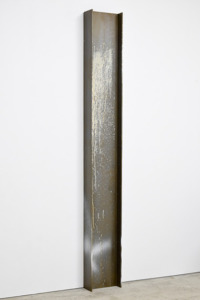A Standard

Honor Fraser Gallery, 01/07/2017 - 02/25/2017
2622 S. La Cienega Blvd., Los Angeles, CA 90034
Honor Fraser Gallery is pleased to announce our third exhibition with Kaz Oshiro. A Standard will be on view beginning Saturday, January 7 with an opening reception from 6 - 8pm.
Kaz Oshiro conflates painting and sculpture to explore our perception of dimension and illusion. Primarily using conventional painting materials, Oshiro builds three-dimensional replicas of familiar, mass-produced objects like kitchen cabinets or trash dumpsters to scale, painting stretched planes of canvas with exacting detail. While Oshiro's art often pushes the concept of representation in painting beyond convention, he has also explored non-objective painting. Featuring intense monochromatic fields of color, his series of “broken” paintings are shaped canvases that bend into corners or lean into one another.
Oshiro's newest subject is the I-beam, the standard construction material that, along with ironwork, characterized the Industrial Revolution. Steel I-beams are emblematic of the rise of an American industrialist class who amassed unprecedented fortunes during a period in which business was largely unregulated. Without steel and I-beams in particular, skyscrapers and modern cities would be unthinkable. When architects turned the focus of their practices to the problem of housing during the population boom following World War II, the I-beam played a pivotal role in the invention of post and beam architecture. This style is endemic to southern California where practitioners like Joseph Eichler, Charles and Ray Eames, and others proposed the use of “off the shelf” prefabricated materials requiring limited treatment to keep costs down and build times short. These experiments that were intended to bring beautiful, affordable housing to the masses are now among the most coveted and expensive architectural properties in the region.
Echoing this irony, Oshiro's new series of I-beams crafted from wood and canvas prompt consideration of the promise of industry to boost economies, the destruction of the environment through mining for raw materials, the origins of American fortune, and the unfulfilled utopian promises of both industrialization and post-war architecture. The paintings accurately mimic the standardization in production that reaches back generations to early American factories. Made by hand and presented in an art context, the paintings reveal the degree of effort required for their making, suggesting that the success of the Industrial Revolution can be attributed in large part to the ceaseless work of exploited laborers adhering to a Protestant work ethic as described by Max Weber in 1905. This integration of an image of a mass-produced object with the subject of American industry repeated over and over again is a meditation on progress.
Though the spare installation, modular forms, and simplicity of composition in the exhibition suggest an homage to minimal art, Oshiro is most interested in what he calls “dirty minimalism,” a variation on the aesthetics of minimalism that allows for subject matter beyond the artwork itself; more Dan Graham than Sol Lewitt, for instance. Indeed, like Graham, Oshiro is deeply connected to music, and the ideas put forward by composers like John Cage, Terry Riley, and Steve Reich, for example, which led the way for alternative approaches to musical form that have been influential for Oshiro. While the simplicity of the installation of the exhibition recalls the repetitive structures of minimal music, the image of the I-beam also conjures the sounds of industrial machinery and construction reflected in early experiments in noise music, rooting these new works in the legacy of the connections between avant-garde art and music in the later part of the twentieth century.
Kaz Oshiro was born in Okinawa, Japan in 1967 and lives in Los Angeles. He received Bachelor and Master of Fine Arts degrees from the California State University, Los Angeles. One-person exhibitions of his work have been presented at Los Angeles County Museum of Art’s Charles White Elementary School Gallery, Los Angeles, CA (2013); Tokyo Institute of Technology, Tokyo, Japan (2007); Las Vegas Art Museum, Las Vegas, NV (2007); and Pomona College Museum of Art, Claremont, CA (2005). His work has been included in thematic exhibitions such as Space Between, The FLAG Art Foundation, New York, NY (2015); Visual Deception II: Into the Future, Bunkamura: The Museum, Tokyo Japan (2014); Between Critique and Absorption: Contemporary Art and Consumer Culture, Haggerty Museum of Art, Marquette University, Milwaukee, WI (2013); Simulacrum, Columbus College of Art and Design, Columbus, OH (2012); Bruce Connor and the Primal Scene of Punk Rock, Museum of Contemporary Art, Denver, CO (2012); Lifelike, Walker Art Center, Minneapolis, MN (2012); New Image Sculpture, McNay Art Museum, San Antonio, TX (2011); Artist’s Museum, Museum of Contemporary Art, Los Angeles, CA (2010); Less is less, more is more, that’s all, CAPC Musée d’art contemporain, Bordeaux, France (2008); One Way or Another: Asian American Art Now, Berkeley Art Museum, Berkeley, CA (2007); Thing: New Sculpture from Los Angeles, Hammer Museum, Los Angeles, CA (2005); Nothing Compared to This, Contemporary Art Center Cincinnati, Cincinnati, OH (2004); and California Biennial, Orange County Museum of Art, Newport Beach, CA (2004).
For More Information